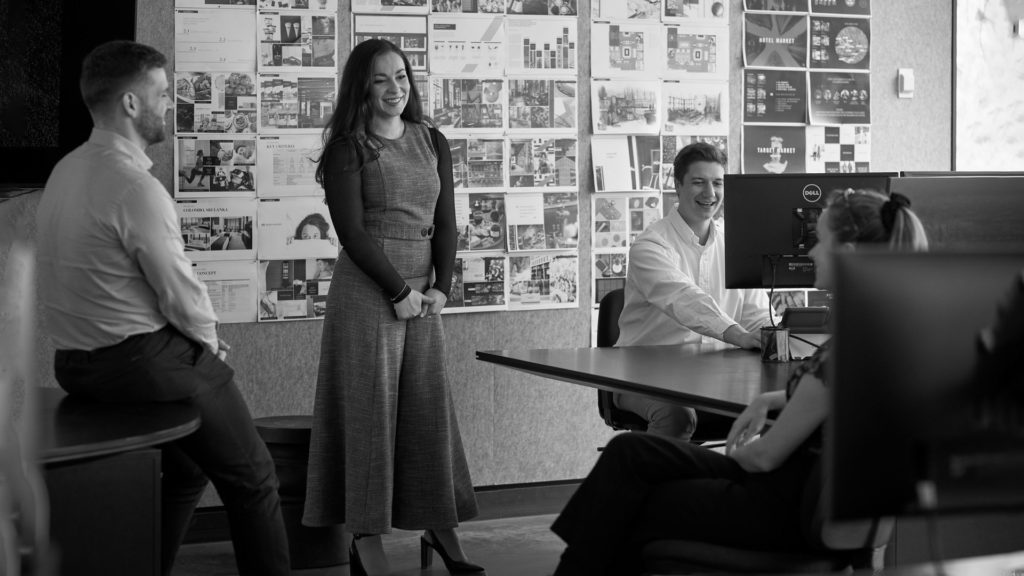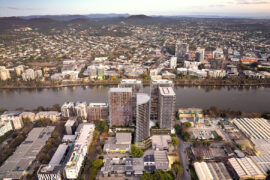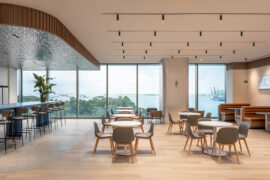From the polycentric model and upside-down buildings to the allure of whimsy and celebration of utility. Three top designers tell us how workplace design is responding to the fluid reality of work.

March 23rd, 2022
While the work-from-home experience necessitated by the pandemic has been widely perceived as a success, the realm of work continues to be underpinned by a layer of uncertainty which – says Andrew Cortese, managing partner at Grimshaw Sydney – calls for a fundamental interrogation of this collective experience, and its unequal impact on various communities, genders, ethnicities and generations.
However, one thing seems to be clear – the physical manifestation of the workplace is here to stay. As important economic drivers and contributors to the urban network, places of work are cultural beacons that enable organisations to communicate their identity; individuals to rally behind a common cause; and teams to collaborate – all whilst brimming with inspiration, creativity and human connection. “Sociability in the workplace is probably one of the biggest requirements. It generates a great sense of collective care, excitement and interaction,” Cortese adds.


Scott Compton, principal at Warren and Mahoney Auckland says that “the role of workplace design is to make the commute worth it.” Compton is an advocate of using experience and surprise to create engaging, interactive spaces which surpass pure functionality and aim to improve the lives of occupants and visitors – like Google’s Auckland headquarters, designed by Warren And Mahoney, certainly does.
Vicki Karavasil, associate at Elenberg Fraser, expresses a similar view – and Market Lane, one of her recently completed projects, is an articulation of the desire to integrate a sense of lifestyle into the everyday routine through an amalgamation of spaces that go beyond the traditional workplace setting. “We call it the polycentric model, or the ‘non-office office’,” she explains.

Beyond the obvious allure of experiences that strive to make places of work worth visiting, how does workplace design respond to the fluidity of post-pandemic circumstances? Karavasil mentions long life, loose fit buildings. “Designed to facilitate change, this generation of buildings is constructed to be sustainably modified as companies adapt the way they work over time,” she explains.
Market Lane embodies this notion as it turns – quite literally – the idea of a building on its head, allowing structural flexibility through the integration of a raised floor system which houses mechanical, electrical and hydraulic services. “Organisations can pack up their workspace and rearrange, without the need to do major building work,” Karavasil explains. “And in the actual planning of the office, having various typologies of working alone, working with groups and having semi-private to private areas is really important.”
Using the pioneering Woodside Building for Technology and Design as an example of a structure that embodies the premise of higher diversification of environments, and prioritises both instrumental and informal learning with the activity based working of the researchers and academics, Cortese says that the flexible workplace will follow the same premise. “You will have a mixture of spaces that display different characters and functions, a mixture of spaces connected through movement, both internal and in intersection with public areas, and all have high levels of environmental performance and comfort though offering a greater diversity of working styles,” he explains.
Related: Future of work part 2 with Grimshaw and Warren and Mahoney

Heightened responsiveness within an agile-forward workplace is also relevant from a safety point of view. “Workplace building research indicates that there will be different compartments that interact with each other,” Cortese explains. “You’ll have wholly contained and naturally ventilated spaces, and spaces which are able to be modified between both modes.” In the event of another pandemic, this approach caters for the heightened reaction as it comes, before it begins to settle down.
“If anything happens, you can just quickly move people around. And then as it begins to settle, you begin to adjust again,” he explains one of key workplace strategies. “Swarming and nesting.”

In this environment of fluidity, the post-pandemic workplace is seeing a shift in its relationship with furniture, too. “The less we make people think about decision making when it comes to this component of their life, the more successful it will become,” says Compton, adding that the utilitarian nature of furniture should be embraced. It’s this restrained simplicity he appreciates Herman Miller’s latest OE1 Workplace collection for. “The new system gets away from all the embellishment and says – to work, actually, all you need is this,” he says.
Scott adds that there is a need for manufacturers to produce lean, sustainable, recyclable products that are practical, intuitive and lightweight. “But then our workplaces are required to have incredibly comfortable, well-being enhancing, and lifestyle improving spaces to couple with them,” he adds. “And that’s the magical blend we’ve got to find.”

Alongside the shift from overcomplicated and overwhelming to light and minimalist, there is a need for workplace fit-outs to be designed with the same premise of flexibility as the commercial, residential and mixed buildings that house them. “When OE1 was first introduced to us it became clear that the overall philosophy behind it is very similar to how we think about designing buildings,” Karavasil recaps her first impressions of the collection from Herman Miller.
Designed to enable agility for organisations, teams and individuals, OE1 by Herman Miller comprises a selection of essential pieces that can be easily moved around and scaled up or down in response to changing needs or preferences of the occupants. “You can pack up, move things around and arrange them in different ways, creating various scenarios based on the needs of the user in that particular moment,” Karavasil says. “You still need to be able to have segments and zones that cater for specific activity-based uses alongside these pieces. They’re accommodating for the working modes, and you can extend upon that with the design and the way you actually curate the spaces.”

OE1 Workplace is a signifier of how profound Herman Miller understands the shifting landscape of the workplace is. Anchored in the notion of fluidity and versatility, the collection enables architects and designers to nurture different modes and styles of work, and adapt to changing goals, needs and preferences, while providing an opportunity to capitalise on the available floor plan to amplify existing spaces and create new ones.
“A multivalent workplace thrives on flexibility and agility, and resilience through adaptability and such can best be physically enabled by environments which equally focus on reconfiguration, personalisation, efficiency, comfort and environmental variation,” says Cortese. “Similarly, all aspects of the workplace from furniture to space are in support of those innate qualities. The re-emergence of the City perhaps arises from how we understand the activities of work and the individuals that find purpose and motivation in that.”
With light and minimalist design that comes in a variety of configurations and colours, OE1’s modular selection of quintessential pieces is bound to help any future-forward organisation fuse flexibility and performance, with the unique sense of purpose and visual expression – and adapt alongside it, no matter which direction the fluid character of our working habits is going to take it next.
In the next instalment of “Future of Work” we look at the correlation between the way we learn and our working preferences, the death of ‘corporate starships” – and the all-important sense of temporary ownership in the environment of constant change.
We think you might like this article about learning, customisations and the death of Death Star with Herman Miller.
INDESIGN is on instagram
Follow @indesignlive
A searchable and comprehensive guide for specifying leading products and their suppliers
Keep up to date with the latest and greatest from our industry BFF's!

Welcomed to the Australian design scene in 2024, Kokuyo is set to redefine collaboration, bringing its unique blend of colour and function to individuals and corporations, designed to be used Any Way!

For Aidan Mawhinney, the secret ingredient to Living Edge’s success “comes down to people, product and place.” As the brand celebrates a significant 25-year milestone, it’s that commitment to authentic, sustainable design – and the people behind it all – that continues to anchor its legacy.

From the spark of an idea on the page to the launch of new pieces in a showroom is a journey every aspiring industrial and furnishing designer imagines making.

Bangalore studio Multitude of Sins elevates true leftovers — not surplus — into a richly layered workspace where waste materials become narrative, structure and sculptural expression.
The internet never sleeps! Here's the stuff you might have missed

Plus Studio and ICD Property have submitted a proposal for a development on Brisbane’s Donkin Street, using a 1.68-hectare former industrial site as a new riverside residential and community destination.

Bean Buro’s Singapore office for Anglo-Eastern is a poetic continuation of their Hong Kong headquarters — a workplace that balances identity and calm.